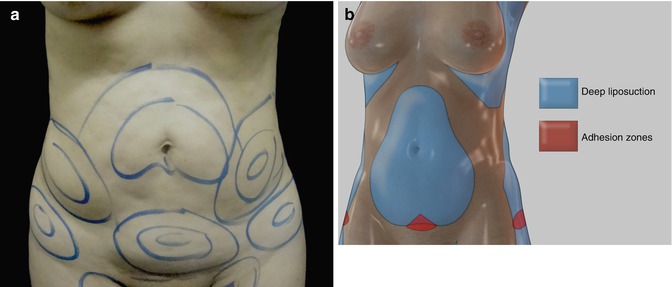and Peter M. Prendergast2
(1)
Elysium Aesthetics, Bogota, Colombia
(2)
Venus Medical, Dublin, Ireland
Introduction
The abdomen is one of the most important regions in aesthetic body contouring. It is also one of the most challenging. Since the early days of aesthetic surgery, various surgical approaches have been used to improve the appearance of the abdomen, including liposuction, abdominoplasty, and various combinations or variations of these procedures [1, 2]. The difficulty in achieving a beautiful, convincing result lies in the complex and elegant arrangement of the anatomical structures beneath the skin. If the surgeon does not have a good knowledge of the anatomy of the fat, musculature, and bony landmarks, the results of surgery become unpredictable. In the early days of aesthetic surgery, complications after abdominal contouring such as asymmetries, unsightly irregularities, and an unnatural appearance explained womens’ reluctance and reservations about undergoing such procedures. Today, liposuction of the abdomen is the most frequently performed procedure for women in aesthetic plastic surgery. Lessons have been learned over the years, allowing us to achieve beautiful results with few complications [3–6].
The ideal abdomen is not just flat; it is a combination of convexities and concavities that follow the anatomy of the bones and muscles underneath [7]. Although variations are multiple and complex, the more defined we want the abdomen to appear, the more thorough and aggressive the treatment should be.
The female torso is characterized by a perfect combination of curves and projections that influence the well-known waist-to-hip ratio. Achieving an ideal waist-to-hip ratio and seamless smooth contours in this zone are important objectives in order to achieve female attractiveness. Achieving the correct degree of definition is a challenge. In women, definition must be appropriate to obtain athletic, slim, and feminine results, while in men, a harder, more muscular appearance is preferred (Fig. 13.1).


Fig. 13.1
Athletic female abdomen
Stealth Incisions
High-definition body sculpting in the female patient involves defining rectus abdominis by revealing its lateral borders and midline, but not the horizontal tendinous intersections. Women almost never request a “six-pack” appearance, but prefer the more feminine “two pack.” Rarely, very athletic patients may want some definition of the rectus bellies horizontally. Once the rectus is defined, the surrounding areas must be carefully sculpted to obtain a natural appearance. Incision placement is important in the female abdomen because the incisions should be hidden yet the entire abdomen must be reached. The ideal incision points should be:
1.
Pubis: In line vertically with the lateral border of the rectus abdominis, 5 mm incisions are placed in the inguinal region within the hair-bearing area. These incisions allow access to almost the entire abdominal region. From these sites, we can define the waist, the rectus abdominis, and the midline.
2.
Umbilicus: For the superior midline and the inferior abdomen definition, an incision is hidden in the navel.
3.
Inframammary Crease: For both sides of the abdomen, an incision must be made in the inframammary crease in line vertically with the lateral border of the rectus abdominis. These incisions are hidden and allow us to access the superior abdomen and flanks. If the breast is not big enough to create an appreciable inframammary fold, we should avoid the inframammary incision so that there are no visible symmetrical scars. In women with small breasts, an areolar incision is preferable to provide access to the upper abdominal region.
Additional Incisions: Some patients may need additional incisions when the fatty tissue is excessive. These may be placed in the anterior axillary fold and the midline at the pubis. Incisions over the abdominal area should be avoided if possible. If one additional incision over the abdomen is essential for access, it should be over the horizontal tendinous intersections of the rectus abdominis. If more than one additional incision is needed, they should be placed asymmetrically to avoid the stigmata of aesthetic surgery (Fig. 13.2).


Fig. 13.2
Incision points with ports in place
The Use of Drains
Drains for women are seldom used in the abdomen. We prefer to leave the distal wounds open for drainage with massage and gravity. The upper incisions are closed with continuous subdermal sutures. When large fat volumes are extracted, we sometimes leave a drain in each pubic incision in order to avoid fluid collections in the flanks and the inguinal regions. A drain is left in the sacral incision.
Markings
Deep Markings
First, mark the most protuberant areas on the abdomen and flanks. There is a central area that has less fat, where the belt creates chronic compression. Mark it in red as an adhesion zone for careful extraction (Fig. 13.3).


Fig. 13.3




Markings for deep extraction: (a) preoperative in vivo markings. (b) General (blue) zones for deep liposuction
Stay updated, free articles. Join our Telegram channel

Full access? Get Clinical Tree








